10 SEO Foolproof Tips to Boost Your Website Traffic

In today’s digital age, driving organic traffic to your website can make the difference between success and failure.
But how do you attract the right audience in an expansive sea of online content?
The answer lies in implementing the right strategies.
Understanding and leveraging SEO can significantly increase your site’s visibility, draw in more visitors, and improve conversion rates.
This article aims to guide you through how you can use search engine optimization to boost your website’s traffic.
Chapters
1. Focus on Long-Tail Keywords

Did you know that according to Wordstream, 50% of search queries consist of four or more words?

So instead of going after the most popular keywords (which are harder to rank if you don’t have an established website), think about the long-tail variations that are more likely to target the right audience.
It’s important to note that these search phrases may have lower monthly searches but they offer higher conversion rates since they’re more specific and related to a person’s actual search intent.
For instance, rather than using ‘’SEO tips”, you could try ‘’How to write SEO-friendly blog posts”.
2. Cover the Topic In-Depth
Another way to improve your website traffic is by providing in-depth content that covers the topic from every angle.
So, instead of targeting single keywords, you should thoughtfully cover the broader topic. This way, your content has a higher chance of ranking for the related keywords as well.
Moreover, providing a comprehensive guide on a subject will make people more likely to link back to your article and share it with their audience.
To streamline the process of finding topic ideas, you can use tools like Ubersuggest or Answer the Public to look up long-tail keywords and questions related to your topic.
For example, if you type “SEO tips” on Answerthepublic, you’ll get a list of related keyword queries that can help you come up with content ideas.

You can also use online communities like Reddit and Quora to get an idea of the questions that people are asking related to your topic.
Once you have a list of ideas, think about how you can provide detailed answers that go beyond providing superficial information. This will demonstrate your authority on the topic and encourage more people to visit your website.
3. Target Featured Snippets
Featured snippets are the answer boxes that appear at the top of search engine result pages.
These are a great way to draw more attention to your website, as well as give credibility to your content.
In order for Google to pick up your content for featured snippets, you need to ensure that it is comprehensive and written in simple language. It also helps to structure your content with headings, subheadings, and bulleted lists.
You can use tools like Ahrefs Content Explorer or SEMrush’s SEO Content Template to identify the kind of content that appears in featured snippets for keywords related to your topic. This will give you an idea of what kind of content works best for this purpose.
Or, you can do a simple search on Google. For example, if you type “What is the best link-building strategy?” in the search bar, you’ll see a featured snippet at the top of the search engine result page.
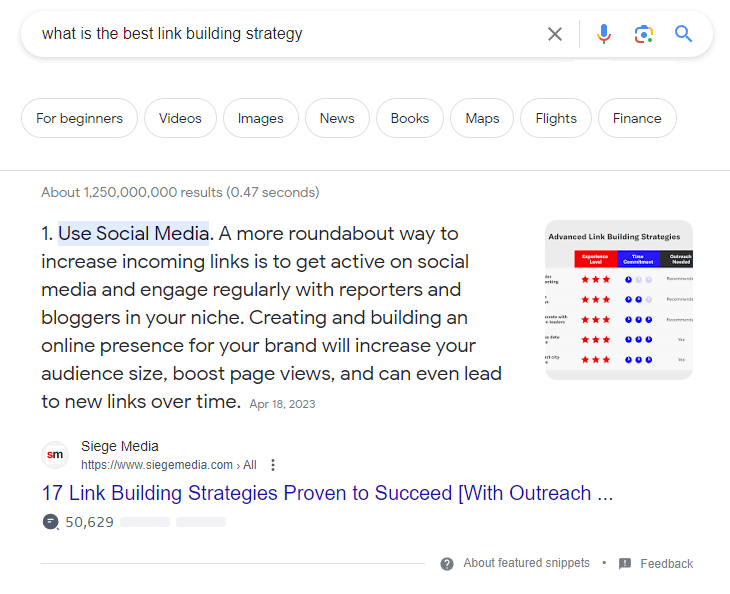
You can then build your content around this structure and format to increase the chances of stealing that position zero.
4. Use Schema Markup
Schema markup is a type of code you can add to your website that tells search engines what kind of content they’re looking at.
Adding schema markup to your website helps search engine crawlers better understand your content, and thus boosts its visibility.
Some of the most common schema markup types are:
- Reviews
- Events
- People
- Products
- Recipes
Tools like Google’s Structured Data Markup Helper can help you create schemas for your website.
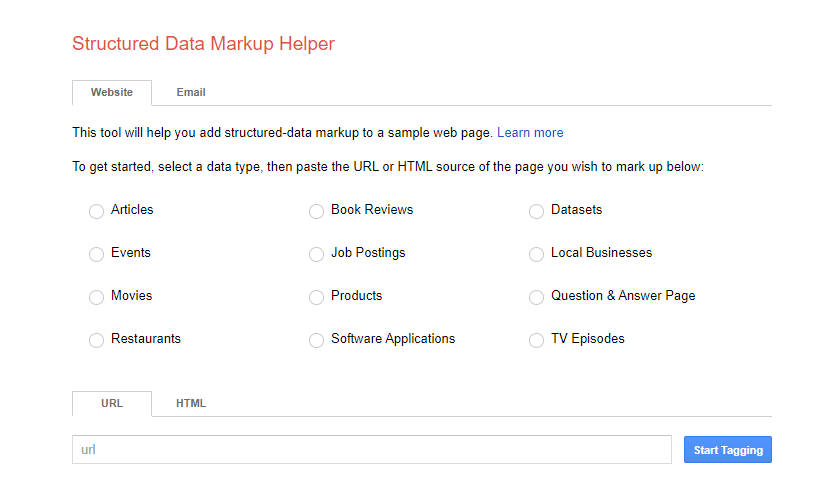
If you test your URL, you’ll check whether the schema is working properly and gives you an idea of how it will appear in search engine result pages.
5. Consider Expert Roundups
Expert roundups are a great way to not only showcase your knowledge but also tap into a larger network of industry experts.
For example, if you’re in the marketing niche, you can reach out to influencers in the industry and ask them relevant questions related to the best marketing strategies.
To find the best questions to make, you can use the People Also Ask section in Goole to get an idea of the questions related to your topic.
Once you have a list of influencers, send them an email with some personalized questions that they can answer in their own words.
Use a template like the one below:

Once you’ve gathered their answers and compiled them into a professional-looking post, you can then share it on your website as well as other social media platforms and communities like Twitter and Reddit.
Make sure that you include links back to the original sources and credit the influencers. This will help you establish relationships with potential customers, promoters, and even collaborators in the long run.
6. Create Original Media
Creating original media is an effective way to break through the clutter of digital content.
In addition to improving your website traffic, it can also increase user engagement as well as build trust among your audience.
You can create original media in the form of videos, screenshots, graphics, infographics, or even podcasts to add more value to your website.
For instance, if you are writing a blog post about creating content marketing strategies, you can add a video clip demonstrating some of the best practices and tips related to it. Or, you could include an infographic that visually explains the content marketing process.
Using original multimedia elements can be incredibly helpful in earning natural backlinks too.
In fact, my orphan pages guide has been linked several times thanks to this original image:
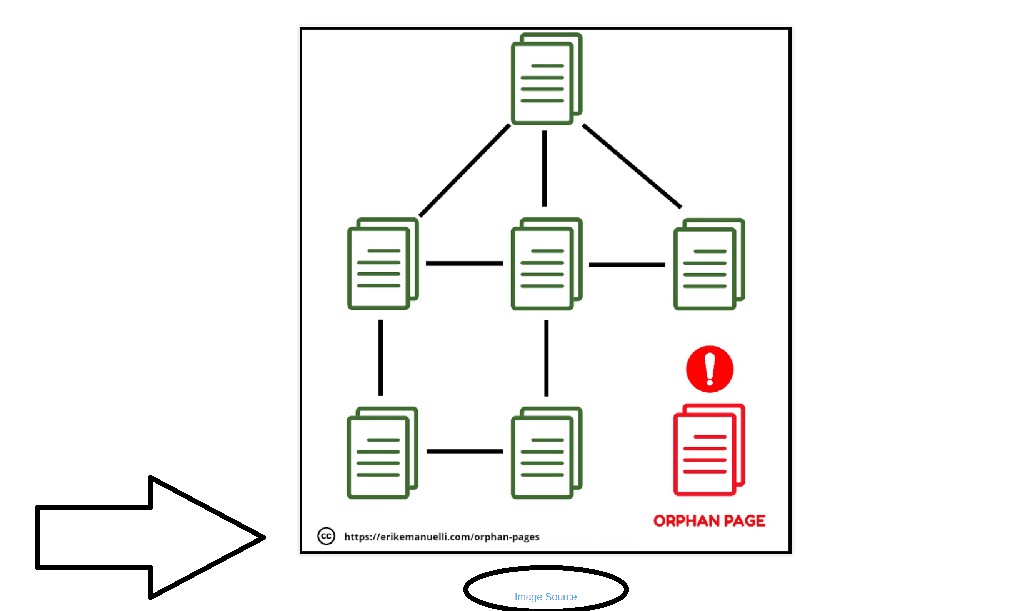
7. Optimize for Voice Search
Voice search is one of the biggest trends in SEO right now, and optimizing for it can help you reach a larger audience.
The key is to use natural language instead of keyword-heavy queries. This means that you should focus on using conversational phrases, complete sentences, and questions when creating your content.
Another way to optimize for voice search is to create FAQ pages that answer the most commonly asked questions related to your topic.
For example, if you are a photographer, you can have an “FAQ page” on your website where you list the answers to common queries like “What type of camera should I buy?” or “How do I take better photos?”.
This will make it easier for search engine crawlers to recognize your content, and thus make it more likely for you to appear higher up in voice searches.
Also, if you have a local business, you should optimize for “near me” searches.
In fact, people are increasingly using location-based keywords in voice searches.
To optimize your content, use geo-targeted keywords, optimize titles and meta descriptions with location-based keywords, include your address, phone number, and business hours on your site, and leverage GoogleMyBusiness by adding your data.
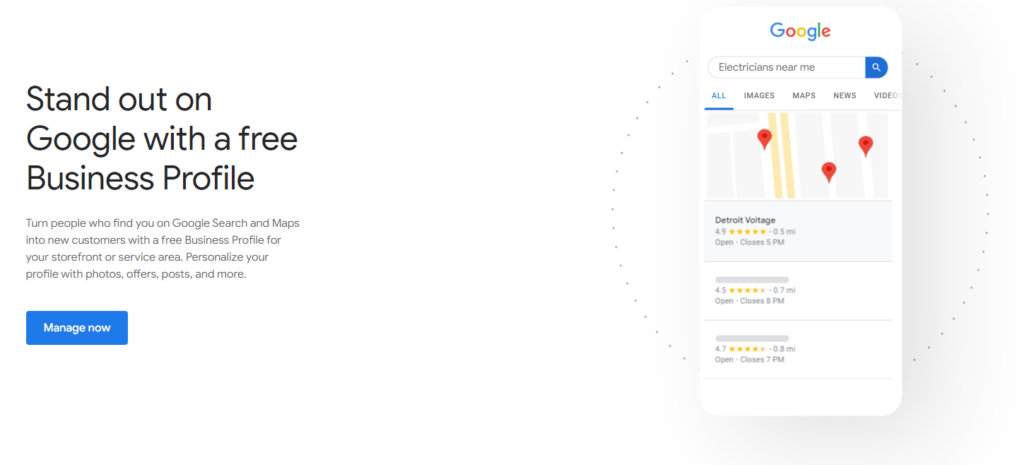
8. Improve Meta Tags
Meta tags are snippets of text that tell search engines what content is on a page. It’s important to optimize them so that they accurately reflect the content and help better organize your website for better crawling.
You should also include keywords related to your topic in meta titles, meta descriptions, and alt-text (for images). This will make it easier for search engine crawlers to recognize your content, and thus make it more likely for you to appear higher up in searches.
In this post, you can find the meta descriptions’ best practices. Some of them include being concise (the recommended length is between 150-160 characters), including actionable words (like “learn,” “discover,” or “download”), and using your target keywords.
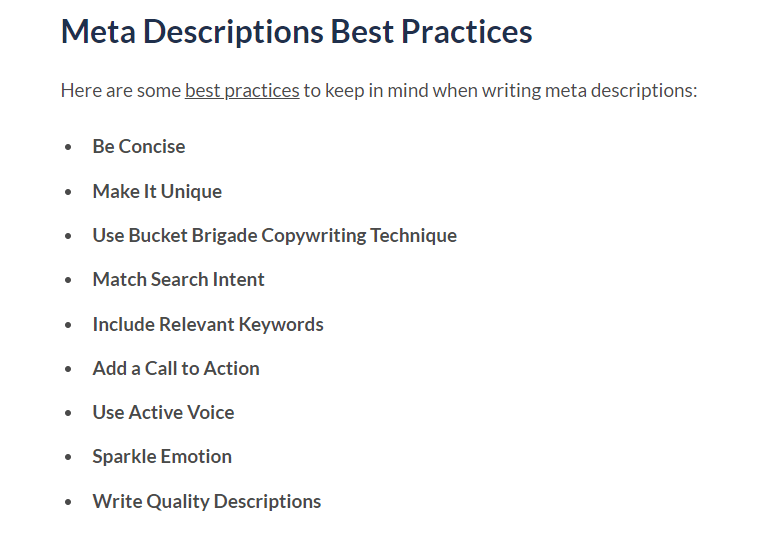
As for the title tag, aim for a length between 50-60 characters. This will help ensure that your entire title is visible on search engine results pages.
Finally, always double-check the meta tags before publishing the content on your site. This way you can make sure that they accurately reflect what the page is about and why it should be relevant to searchers.
9. Work on Page Speed
Page speed is an important factor for SEO. If your site takes too long to load, it can negatively impact user experience and cause search engines to devalue your content.
To fix this, you can compress images using a tool such as TinyImage, reduce the number of redirects, enable browser caching, and remove unnecessary plugins and widgets. Additionally, you should also simplify the design of your site and use a fast hosting provider.
You can also use tools like Google’s PageSpeed Insights to assess the performance of your website, and get suggestions on how to improve it.
The concept of page speed is essential for both desktop and mobile users. In fact, Google’s Mobile-First Indexing prioritizes mobile pages in search engine rankings and mentioned in its research that
The most important thing to optimize for mobile SEO is to implement a responsive design. This will make it easier for search engine crawlers to understand your content and, consequently, rank it higher in searches.
Once you have optimized the speed of your site, focus on optimizing user experience. This means creating a website that is easy to navigate and use on any device.
Make sure to include clear calls-to-action (CTAs), use legible font sizes, and provide concise descriptions to help search engine users understand what the page is about.
10. Generate Quality Backlinks
Quality backlinks are essential for SEO, as they help increase your website’s trustworthiness in the eyes of search engines.
To get more backlinks, you should create content that is useful, relevant, and entertaining to readers. Also, make sure to include links to external sources whenever you can.
You can also use tools like BuzzSumo to determine the most popular content related to your topic, and use it as inspiration for creating similar but unique content. This will be more likely to generate backlinks from other websites.
In addition, you can also reach out to influencers or bloggers who create content related to yours, and ask them if they’d be interested in linking to your work.
Other white-hat SEO link-building strategies include creating infographics, press releases, and guest posts.
No matter what strategies you use to build backlinks, always ensure the links are from reliable sources and relevant to your content. This will help bring more trustworthiness to both your website and content.
Final Thoughts
By following these SEO tips, you will be able to improve your website’s ranking in search engine results pages and drive more organic traffic to your site.
Remember to focus on creating quality content, optimizing meta tags, improving page speed and user experience, and generating backlinks from reliable sources.
These steps can sound overwhelming at first, but once you understand the basics of SEO, it will become easier to implement them on your website.
About the Author
Erik Emanuelli
Content Writer, SEO specialist
Erik Emanuelli has been blogging since 2010. He’s now sharing what he has learned on his website. Find more insights about SEO and blogging here.
Link: More about SEO from Erik
FAQ
What is SEO website traffic, and why is it important for websites?
SEO website traffic refers to the organic (non-paid) visitors a website receives through search engine results. It is crucial for websites because it brings in targeted, relevant visitors who are more likely to convert.
How does SEO help in increasing website traffic?
SEO optimizes a website’s content and structure to rank higher in search engine results, making it more discoverable to users searching for relevant information.
What are the primary factors that influence SEO-driven website traffic?
The primary factors include keyword optimization, high-quality content, backlinks, mobile-friendliness, site speed, and user experience.
How long does it typically take to see an increase in SEO-driven website traffic?
The time it takes to see significant results can vary, but it often takes several months of consistent SEO efforts to see a noticeable increase in traffic.
What role do keywords play in driving organic website traffic?
Keywords are crucial in SEO as they help search engines understand the content of a webpage. Proper keyword research and optimization can attract more organic traffic.
Can social media and content marketing strategies complement SEO efforts to boost website traffic?
Yes, social media promotion and content marketing can drive additional traffic to a website and enhance its SEO efforts.
What are some common SEO mistakes that can hinder website traffic growth?
Common mistakes include keyword stuffing, poor content quality, neglecting mobile optimization, and ignoring technical SEO issues.
Is it necessary to hire an SEO professional or agency to increase website traffic through SEO?
While hiring professionals can be beneficial, website owners can also learn and implement SEO best practices themselves. It depends on the complexity of the website and the resources available.
How can businesses track and measure the impact of SEO efforts on their website traffic?
Businesses can use tools like Google Analytics and SEO-specific platforms to monitor website traffic, keyword rankings, and user behavior.
What are some advanced strategies for maximizing SEO-driven website traffic and conversions?
Advanced strategies include optimizing for featured snippets, building authoritative backlinks, conducting competitor analysis, and focusing on user intent to enhance content relevance and drive more targeted traffic.
How does local SEO impact website traffic, especially for businesses with physical locations?
Local SEO helps businesses appear in local search results, attracting nearby customers and increasing foot traffic to physical locations.
What is the significance of on-page SEO elements like meta tags, headers, and URL structures in driving website traffic?
On-page SEO elements improve a website’s visibility in search results and make it more user-friendly, ultimately driving more organic traffic.
How can website owners ensure their SEO efforts align with the latest search engine algorithm updates?
Staying informed about algorithm changes, following SEO news, and adapting strategies accordingly helps ensure alignment with search engine updates.
What is the role of content freshness and regular updates in maintaining and growing SEO-driven website traffic?
Regularly updating and adding fresh, relevant content signals to search engines that a website is active and can help improve search rankings and traffic.
Can paid advertising, such as pay-per-click (PPC), complement SEO efforts in driving website traffic?
Yes, PPC advertising can be used to target specific keywords and audiences, driving additional traffic while SEO efforts continue to grow organically.
How does mobile optimization impact website traffic, considering the prevalence of mobile device usage for internet access?
Mobile optimization is critical, as search engines prioritize mobile-friendly websites, and a large portion of users access the internet via mobile devices.
What is the significance of website loading speed in retaining visitors and boosting SEO-driven traffic?
Faster-loading websites provide a better user experience, reduce bounce rates, and are favored by search engines, resulting in higher rankings and more traffic.
How can businesses leverage long-tail keywords to attract highly targeted organic website traffic?
Long-tail keywords are specific phrases that can attract users with precise intentions. Optimizing content for these keywords can result in more relevant and valuable traffic.
What is the role of user experience (UX) in converting website traffic into customers or leads?
A positive UX, including easy navigation, clear calls to action, and responsive design, can lead to higher conversion rates, turning website visitors into customers or leads.
Are there any ethical or black-hat SEO practices that website owners should avoid to prevent harming their website traffic and reputation?
Website owners should avoid practices like keyword stuffing, cloaking, and link schemes, as these can lead to search engine penalties and damage a website’s reputation and traffic.
How can content marketing strategies, such as blogging and guest posting, contribute to increased website traffic through SEO?
Content marketing creates valuable, shareable content that attracts organic traffic, earns backlinks, and establishes a website’s authority in its niche.
What are the benefits of conducting regular SEO audits for maintaining and improving website traffic?
SEO audits help identify technical issues, optimize on-page elements, and ensure a website’s ongoing alignment with search engine ranking factors.
How does user intent play a role in SEO strategies aimed at capturing high-converting traffic?
Understanding user intent allows websites to create content and target keywords that align with what users are looking for, increasing the likelihood of conversion.
What impact do backlinks, or inbound links, have on SEO-driven website traffic?
Backlinks from authoritative websites can boost a website’s authority, improve search rankings, and drive referral traffic.
Can optimizing images and multimedia elements on a website contribute to SEO-driven traffic?
Yes, optimizing images and multimedia elements for SEO improves page load times, enhances user experience, and can result in higher search rankings and traffic.
What are the potential risks of relying solely on SEO for website traffic without diversifying traffic sources?
Overreliance on SEO can make a website vulnerable to algorithm changes, making it crucial to diversify traffic sources through channels like social media, email marketing, and paid advertising.
How can local businesses use SEO to attract customers within their geographic area?
Local SEO techniques, such as optimizing for “near me” searches and creating Google My Business profiles, can help local businesses attract nearby customers.
What is the role of user-generated content and reviews in SEO-driven website traffic and credibility?
User-generated content and reviews can improve a website’s visibility, trustworthiness, and overall SEO performance by providing fresh, authentic content and social proof.
How can long-term SEO strategies be developed to maintain consistent website traffic growth over time?
Long-term strategies involve continuous content creation, link building, regular technical maintenance, monitoring analytics, and staying updated on industry trends.
What resources and tools are available for website owners looking to learn more about SEO and improve their website traffic?
There are numerous online resources, blogs, courses, and SEO tools available to help website owners gain expertise and optimize their websites for increased traffic.
Create more and better content
Check out the following resources and Grow!